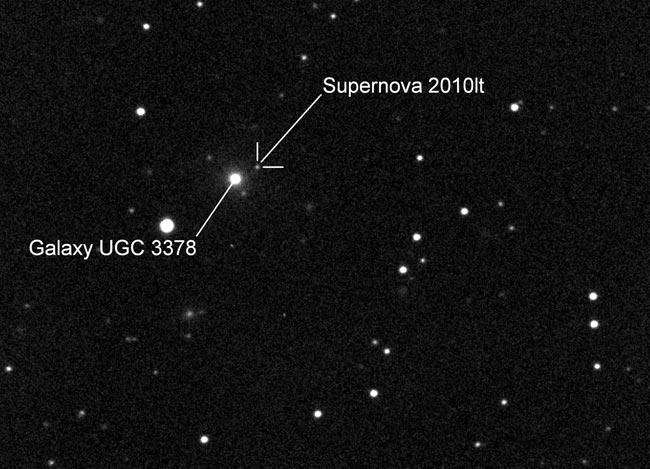10-year-old Is Youngest to Discover Exploding Star

It may have only appeared as a tiny, glowing spot hovering over a distant galaxy, but the sight made a precocious 10-year-old amateur astronomer the youngest person ever to have detected a stellar explosion called a supernova.
Kathryn Aurora Gray of Fredericton, New Brunswick in Canada discovered the supernova explosion in a galaxy, called UGC 3378, within the faint constellation of Camelopardalis. The galaxy is approximately 240 million light-years away.
"I'm really excited. It feels really good," Gray told the Toronto Star.
Gray made the discovery on Jan. 2 using images that were taken of galaxy UGC 3378 on New Year's Eve. The supernova was then verified by Illinois-based amateur astronomer Brian Tieman and Arizona-based amateur astronomer Jack Newton, who then reported it to the International Astronomical Union's Central Bureau for Astronomical Telegrams.
Gray reported the stellar explosion under the supervision of her father, Paul Gray, who has made six prior supernova discoveries, and family friend David Lane, who has found three others himself. The photos of galaxy UGC 3378 were taken using a telescope belonging to Lane.
Supernovas are powerful and violent explosions that signal the deaths of stars several times more massive than our sun. These cosmic blasts are interesting to astronomers because they manufacture most of the chemical elements that went into creating the Earth and other planets. Distant supernovas can also be used to estimate the size and age of our universe.
The last supernova found in our galaxy occurred several hundred years ago, and they are considered relatively rare events. Astronomers can increase their odds of discovering a supernova by repeatedly checking and comparing many different galaxies.
Breaking space news, the latest updates on rocket launches, skywatching events and more!
A new supernova reveals itself as a bright point of light that was not present in previous observations. And, since a supernova can outshine millions of ordinary stars, it is often easy to spot one with a modest telescope, even in distant galaxies like UGC 3378.
Despite being the discoverer of this one, Gray didn't get to bestow a name on the object, which is known simply as Supernova 2010lt.

Denise Chow is a former Space.com staff writer who then worked as assistant managing editor at Live Science before moving to NBC News as a science reporter, where she focuses on general science and climate change. She spent two years with Space.com, writing about rocket launches and covering NASA's final three space shuttle missions, before joining the Live Science team in 2013. A Canadian transplant, Denise has a bachelor's degree from the University of Toronto, and a master's degree in journalism from New York University. At NBC News, Denise covers general science and climate change.
